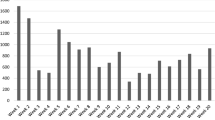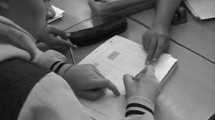Abstract
TRADITIONAL METHODS for teaching science courses at the post-secondary level employ a lecture format of instruction in which the majority of students are passively listening to the instructor and jotting down notes. Current views of learning and instruction challenge the wisdom of this traditional pedagogic practice by stressing the need for the learner to play an active role in constructing knowledge. The emerging technology of classroom communication systems offers a promising tool for helping instructors create a more interactive, student-centered classroom, especially when teaching large courses. In this paper we describe our experiences teaching physics with a classroom communication system calledClasstalk. Classtalk facilitated the presentation of questions for small group work as well as the collection of student answers and the display of histograms showing how the class answered, all of which fed into a class-wide discussion of students’ reasoning. We foundClasstalk to be a useful tool not only for engaging students in active learning during the lecture hour but also for enhancing the overall communication within the classroom. Equally important, students were very positive aboutClasstalk-facilitated instruction and believed that they learned more during class than they would have during a traditional lecture.
Similar content being viewed by others
References
Anderson, C.W. (1987). Strategic teaching in science. In B.F. Jones, A.S. Palincsar, D.S. Ogle & E.G. Carr (Eds.),Strategic teaching and learning: Cognitive instruction in the content areas (pp. 73–91). Alexandria, VA: Association for Supervision and Curriculum Development.
Anzai, Y. & Simon, H.A. (1979). The theory of learning by doing,Psychological Review, 86, 124–140.
Bonwell, C.C. & Eison, J.A. (1991). Active learning: Creating excitement in the classroom.ASHE-ERIC Higher Education Report No. 1. Washington, DC: ERIC Clearinghouse on Higher Education, The George Washington University.
Brown, J.S., Collins, A. & Duguid, P. (1989), February. Situated cognition and the culture of learning,Educational Researcher, 18, 32–42.
Chi, M.T.H., Feltovich, P.J. & Glaser, R. (1981). Categorization and representation of physics problems by experts and novices,Cognitive Science, 5, 121–152.
Claxton, C.S. & Murrell, P.H. (1987). Learning styles: Implications for improving educational practices.ASHE-ERIC Higher Education Report No. 4. Washington, DC: ERIC Clearinghouse on Higher Education, The George Washington University.
Clement, J.J. (1982a). Algebra word problem solutions: Thought processes underlying a common misconception,Journal for Research in Mathematics Education, 13, 16–30.
Clement, J.J. (1982b). Students’ preconceptions in introductory mechanics,American Journal of Physics, 50, 66–71.
Cole, M. (1985). The zone of proximal development: Where culture and cognition meet. In J.V. Wertsch (Ed.),Culture, communication and cognition: Vygotskian perspectives. Cambridge, UK: Cambridge University Press.
Dufresne, R., Gerace, W.J., Hardiman, P.T. & Mestre, J.P. (1992). Constraining novices to perform expert-like problem analyses: Effects on schema acquisition,Journal of the Learning Sciences, 2, 307–331.
Garner, R. (1990). When children and adults do not use learning strategies: Toward a theory of settings,Review of Educational Research, 60, 517–529.
Glaser, R. (1992). Expert knowledge and processes of thinking. In D. Halpern (Ed.),Enhancing thinking skills in the sciences and mathematics (pp. 63–75). Hillsdale, NJ: Lawrence Erlbaum Associates.
Glaser, R. (1994). Learning theory and instruction. In G. d’Ydewalle, P. Eelen & P. Bertelson (Eds.),International perspectives on psychological science, Vol. 2: The state of the art (pp. 341–375). Hove, UK: Lawrence Erlbaum Associates.
Gullette, M.M. (1992). Leading discussion in a lecture course: Some maxims and an exhortation,Change, 24(2), 32–39.
Halloun, I.A. & Hestenes, D. (1985). The initial knowledge state of college physics students,American Journal of Physics, 53, 1043–1055.
Hestenes, D. & Wells, M. (1992, March). A mechanics baseline test,The Physics Teacher, 30, 141–158.
Hestenes, D., Wells, M. & Swackhamer, G. (1992, March). Force concept inventory,The Physics Teacher, 30, 159–166.
Hewson, P.W., Kerby, H.W. & Cook, P.A. (1995). Determining the conceptions of teaching science held by experienced high school science teachers,Journal of Research in Science Teaching, 32, 503–520.
Johnson, D.W., Johnson, R.T. & Smith, K. (1991) Cooperative learning: Increasing college faculty instructional productivity.ASHE-ERIC Higher Education Report No. 4. Washington, DC: ERIC Clearinghouse on Higher Education, The George Washington University.
Jonassen, D.H. (1995). Computers as cognitive tools: Learning with technology and not from technology,Journal of Computing in Higher Education, 6, 40–73.
Larkin, J.H. (1980). Skilled problem solving in physics: A hierarchical planning model,Journal of Structural Learning, 6, 271–297.
Larkin, J.H. (1981). Enriching formal knowledge: A model for learning to solve problems in physics. In J.R. Anderson (Ed.),Cognitive skills and their acquisition (pp. 311–334). Hillsdale, NJ: Lawrence Erlbaum Associates.
Larkin, J.H. (1983). The role of problem representation in physics. In D. Gentner and A.L. Stevens (Eds.),Mental models (pp. 75–98). Hillsdale, NJ: Lawrence Erlbaum Associates.
Lave, J. (1988).Cognition in practice: Mind, mathematics and culture in everyday life. Cambridge, UK: Cambridge University Press.
Lightman, A.P., Miller, J.D. & Leadbeater, B.J. (1987). Contemporary cosmological beliefs. In J.D. Novak (Ed.),Proceedings of the second international seminar on misconceptions and educational strategies in science and mathematics, Vol. III (pp. 309–321). Ithaca, NY: Department of Education, Cornell University.
Mazur, E. (1993).Peer instruction: A user’s manual. Unpublished manuscript, Department of Physics, Harvard University, Cambridge, MA.
McDermott, L.C. (1984). Research on conceptual understanding in mechanics,Physics Today, 37(7), 24–32.
Mestre, J. & Touger, J. (1989, September). Cognitive research: What’s in it for physics teachers,The Physics Teacher, 27, 447–456.
Pintrich, P.R. & De Groot, E. (1990). Motivational and self-regulated learning components of classroom academic performance,Journal of Educational Psychology, 82, 33–40.
Pintrich, P.R., Marx, R.W. & Boyle, R.A. (1993). Beyond cold conceptual change: The role of motivational beliefs and classroom contextual factors in the process of conceptual change,Review of Educational Research, 63, 167–199.
Pintrich, P.R. & Schrauben, B. (1992). Students’ motivational beliefs and their cognitive engagement in classroom academic tasks. In D. Schunk & J. Meece (Eds.),Student perceptions in the classroom: Causes and consequences (pp. 149–183). Hillsdale, NJ: Lawrence Erlbaum Associates.
Pyramid Film & Video.A Private Universe.Santa Monica, CA.
Resnick, L.B. (1983). Mathematics and science learning: A new conception,Science, 220, 477–478.
Resnick, L.B. (1987).Education and learning to think. Washington, DC: National Academy Press.
Sadler, P.M. (1987). Misconceptions in astronomy. In J.D. Novak (Ed.),Proceedings of the second international seminar on misconceptions and educational strategies in science and mathematics, Vol. III (pp. 422–425). Ithaca, NY: Department of Education, Cornell University.
Schauble, L. (1990). Belief revision in children: The role of prior knowledge and strategies for generating evidence,Journal of Experimental Child Psychology, 49, 31–57.
Seymour, E. (1995, May). Revisiting the ‘problem iceberg’: Science, mathematics, and engineering students still chilled out,Journal of College Science Teaching, 24, 392–400.
Sokoloff, D.R. (1994). Enhancing physics learning in lecture with interactive, microcomputer-based demonstrations,AAPT Announcer, 24(4), 63.
Stetten, G.D. & Guthrie, S.D. (1995). Wireless infrared networking in the Duke paperiess classroom,T.H.E. Journal, 23(3), 87–90.
Strike, K.A. & Posner, G.J. (1992). A revisionist theory of conceptual change. In R. Duschl & R. Hamilton (Eds.),Philosophy of Science, Cognitive Psychology, and Educational Theory and Practice (pp. 147–176). Albany, NY: SUNY.
Tobias, S. (1990).They’re not dumb, they’re different: Stalking the second tier. Tucson, AZ: Research Corporation.
Tobin, K. (1986). Effects of teacher wait time on discourse characteristics in mathematics and language arts classes,American Educational Research Journal, 23, 191–200.
Van Heuvelen, A. (1991). Overview, case study physics,American Journal of Physics, 59, 898–907.
von Glasersfeld, E. (1989). Cognition, construction of knowledge, and teaching,Synthese, 80, 121–140.
von Glasersfeld, E. (1992). A constructivist’s view of learning and teaching. In R. Duit, F. Goldberg & H. Niedderer (Eds.),The proceedings of the international workshop on research in physics education: Theoretical issues and empirical studies (Bremen, Germany, March 5–8, 1991). Kiel, Germany: IPN.
Vygotsky, L.S. (1978).Mind in society: The development of higher psychological processes. Cambridge, MA: Harvard University Press.
Wandersee, J.H. (1983). Students’ misconceptions about photosynthesis: A cross-age study. In H. Helm & J. Novak (Eds.),Proceedings of the international seminar on misconceptions in science and mathematics (pp. 441–465). Ithaca, NY: Department of Education, Cornell University.
Wilson, J. (1994, December). The CUPLE physics studio,The Physics Teacher, 32, 518–523.
Author information
Authors and Affiliations
Corresponding author
Additional information
ABOUT THE AUTHORS
Robert Dufresne received his Ph.D. in theoretical nuclear physics from the University of Massachusetts at Amherst where he is now a Research Assistant Professor in the Department of Physics and Astronomy. He is principal investigator on several federal grants. His current interests include investigations of problem-solving performance among novices and experts and research on the effectiveness of different instructional approaches using classroom communication systems.
William Gerace has a Ph.D. in theoretical nuclear physics from Princeton University. He is a faculty member in the physics department at the University of Massachusetts and director of the Scientific Reasoning Research Institute. He has published extensively in both nuclear physics and physics education. For the last fifteen years, he has been engaged in research and development in physics education. Professor Gerace has been a principal investigator on numerous federal grants. His educational research has focused on investigations of expert-novice differences in physics and on using findings from this research to develop a framework for knowledge acquisition, organization, and use. He is currently applying this framework in the development of a high-school physics curriculum that focuses on concept-based problem solving and in the development of general instructional strategies and curriculum materials for use with classroom communication systems.
William Leonard has a Ph.D. in theoretical nuclear physics from the University of Massachusetts at Amherst where he is a Research Assistant Professor in the Department of Physics and Astronomy. He has worked in educational research and development for over 10 years. His current interests include developing a high school physics curriculum called “Minds-on Physics” and applying cognitive models to the development of curricula for classroom communication systems.
Jose Mestre received his Ph.D. in theoretical nuclear physics from the University of Massachusetts at Amherst where he is a professor of physics. For the last decade and a half, he has been engaged in cognitive studies of problem solving in mathematics and physics. His current interests focus on the acquisition and use of physics knowledge by experts and novices, and on developing physics curricula that promote conceptual development through problem solving. Professor Mestre has published numerous articles and two books on problem solving in the sciences and mathematics and has served on committees and boards for the National Research Council, the College Board, the Educational Testing Service, and the American Association of Physics Teachers.
Laura Wenk is a doctoral student in Curriculum Reform in the School of Education at the University of Massachusetts at Amherst. She received an M.S. in Botany and an M.Ed. in secondary science education from the University of Massachusetts. She taught biology and physical science at the high-school level for six years. Her current research interests include investigations of how active learning in science lecture courses affect women’s attitudes towards science, and their perceptions of themselves as scientists.
Rights and permissions
About this article
Cite this article
Dufresne, R.J., Gerace, W.J., Leonard, W.J. et al. Classtalk: A classroom communication system for active learning. J. Comput. High. Educ. 7, 3–47 (1996). https://doi.org/10.1007/BF02948592
Issue Date:
DOI: https://doi.org/10.1007/BF02948592




